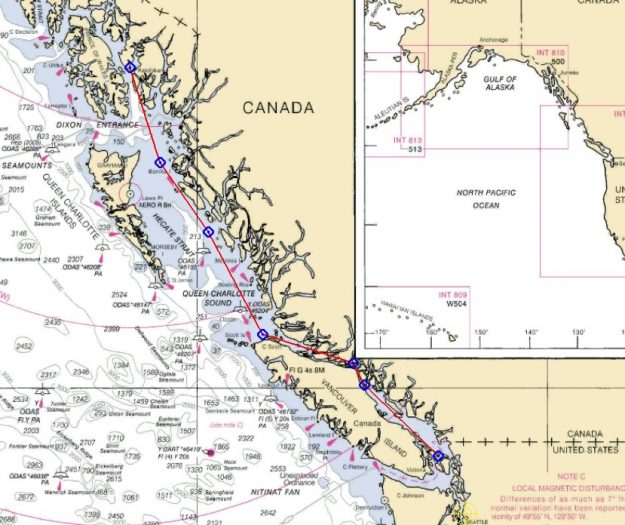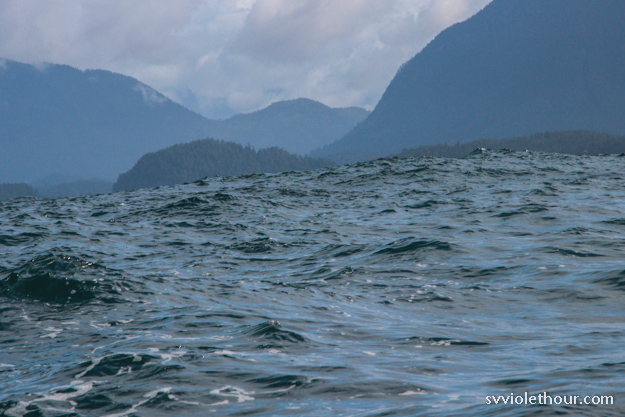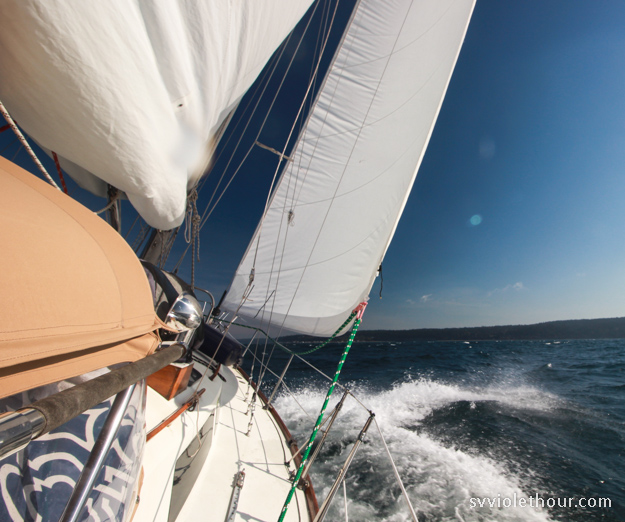2020 was our 3rd year of full-time cruising, but certainly not a normal one. The border closure and pandemic meant we didn’t sail very far and didn’t get to go to our favorite cruising waters (in BC), leaving a big hole in our sailing rhythm. An intrinsic part of cruising is travel to new places. While there may be some who are content sitting mostly in one area year after year, 2020 taught us we’re not that type. The travel part of cruising – nomading, voyaging, exploring – is an essential element for us.
Last year this time our months of preparation got cancelled by the pandemic and we spent the next six months trying to figure out how to make the best of the new limitations on our lifestyle. Our biggest sailing adventure was sailing around Whidbey Island (lol).
After waiting a year for BC to reopen, we’re calling it quits and making a decision for very different cruising plans – Alaska will replace BC as our new cruising territory! (we’re moving our home – ie, boat – to Alaska as our permanent residency)

British Columbia
We’ll be thru transiting through BC, which means we’re not allowed to step foot on shore – we can stop to sleep at anchor each night and at ports for essential purposes only (fuel, water, groceries if you can have them delivered to the dock).
This will be very different from our usual trips into BC, where it takes us about 2 months to get three quarters of the way to Alaska. We won’t have any meandering through Desolation Sound early season, or 5 days on a detour up Dean Channel on the Central Coast. The saddest part for us will be having to pass by Pruth Bay and Calvert Island. And being cooped up on the boat that long, not able to walk or hike on shore will be a challenge.
It’s approximately 600-700 nautical miles and we expect to take 3-4 weeks because we’re a slow moving sailboat, not a motorboat, and will also have to wait for weather windows since this is early season. Thru transiting means some very long days and since it is early season we’ll likely have to spend 3 to 7 days sitting at anchor waiting for weather windows (waiting out gales at key gates like Cape Caution, Dixon Entrance, and Johnstone Strait).

Routes
While the typical route to Alaska is through the Inside Passage (which is primarily BC), we’ve heard from other cruisers who are considering going outside – taking an offshore passage to Alaska. I guess this is partly motivated by the Canadian restrictions – if you can’t set foot on shore, why bother taking an inland route?
We’ve pretty much ruled that out for ourselves, unless we were forced to take it. Here’s our thinking on it (which is naturally pretty person and boat specific):
Pros of offshore:
- Shorter time overall, due to ability to safely sail/motor overnight (non-stop). Doing that on the inside passage you would almost certainly hit some logs and trees in the water at some point.
- Easier navigationally – no tidal passes to deal with or frequent course changes for logs and traffic.
- Offshore passage practice, night watch practice.
Cons:
- Sailing/motoring overnight is difficult / exhausting, especially with only 2 people onboard!
- Weather – gales and storms on the northwest Pacific coast can be truly dangerous in the early season, so taking the ocean route requires careful weather timing / forecasting.
- Reduces sailability – many people think the offshore passage means more sailing, but we think the opposite! In our experience, and due to our boat’s design, we sail a lot more on the inside.
On the ocean we have a narrower range of sailable wind – because on flat inside water we can sail well downwind in 8 kts breeze, but on the Pacific in 8-12 ft swell (sloppy leftovers from faraway systems / gales) that same wind level is not really enough and you quite likely will be motoring.
We’ve also found on the inside, the straits tend to channel and funnel wind, plus you often have diurnal wind.
Our plan is to do option A unless Canada stops permitting it (which seems highly unlikely since it would decrease safety at sea). But we’d be very much interested in hearing what the outside route was like from some of the people who end up taking it.

Ocean swell with little wind, no thanks. Off the west coast of Vancouver Island, July 2019.
Concerns
Either of these options will be more challenging than the typical way a boat gets to Alaska. We’re well prepared for it and have experience on most of the route, but I wouldn’t recommend this for everyone unless you’re well prepared and know what to expect. We’ve basically prepared for an unassisted ocean passage and complete self-sufficiency – we have over 4 weeks of food onboard, and infinite water if we harvest what falls out of the sky.
Nevertheless there are a few challenges with thru-transiting to keep in mind:
- Water and fuel – we’re a low tankage boat (29 gallons water, 16 gallons fuel) so we’ll be roughly doubling that with jerry cans on deck. We can stop in ports to refuel / get water, but we probably will want to do that as little as possible.
- This may push us to go faster than normal, risking exposure to unpleasant gales and/or more motoring.
- It may get very lonely and boring – we won’t be able to go to shore for any of the usual cruising entertainments, and we won’t see any other humans or boats most of the time, and even if we do we won’t be able to talk to them.
- Early-season weather: Most boaters consider Alaska’s cruising season to be shorter than in the Salish Sea. We know very few boaters who have cruised extensively there in April or early May. We may have to deal with more cold, rainy, dark days and/or more frequent gales.
- Mechanical issues / fatigue: I’m not sure what we’d be allowed to do if we had some kind of serious boat issue. On our last northbound voyage (2019) we stopped in Campbell River for 3 days to repair our autopilot mount. If we had a similar issue this year we’d probably have to just push on through.

We know we’ll get plenty of this…

But are hoping for some of this too…
Boat Projects
Due to not being able to cruise much last year, we worked instead – on remote jobs and boat projects. We were prepared to sail to Alaska last year, but we’re now doubly prepared! We made a number of upgrades this year to increase our self-reliance / remote capabilities:
- Iridium Go – satellite internet for weather forecasting in places that have no cellular
- WeBoost cellular booster
- MIMO cellular router
- Lots of engine work / maintenance – new raw water pump, exhaust elbow, exhaust temp alarm, painted
We’ll also be restarting our herb garden (last year was the first time we did it).
If you’re heading north this year around the same time, keep in touch and we hope to see you in Alaska!

Great stuff! Glad you are getting out of the box. The inside/outside argument is an interesting one. Basically time vs comfort and security… And with the short season and non-stop travel it’s made even harder.
We are hoping that we can make it out for May but are still wary about cross provincial traffic. Any plans for coming back down or are you thinking about leaving the boat up there for there for winter?
Currently we’re thinking of it as we’re moving to Alaska, with no other plans. But if the border reopens in July or August we might want to come back south. Or might be enticed to stay in Alaska for a winter to be positioned for further ranging exploration next year (ex, Kenai peninsula). But an Alaska winter would be much tougher than a San Juans winter.
Hi there-
Followed you for the last 6mo we have been in PNW and sailing liveaboards and learned tons as we are Cali transplants! Thanks for sharing all your insights… has def helped us adjust.
We have a piece of software which uses AIS that logs your sails without a need to start or stop anything at saillogger.com and it’s 100% free and also allows you to see an animated view of your journey(s). We would love more beta testers (esp in northern latitudes) if you are able to run it and log your sales that would be cool. Happy to troubleshoot or help you install if needed.
Either way…. happy passage making. As an Alaskan myself I know once you reach the border you can expect helpful and friendly people and a wild landscape like nothing else in America!!